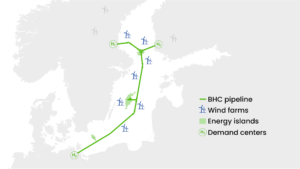Increased electricity generation is a prerequisite for the maritime transition
Electrification is an important part of the transition of many industries, but not everything will be electrified. Shipping is one such example where other fossil-free fuels are needed, but which need electricity to be produced.
/https%3A%2F%2Fgotlandsbolaget.se%2Fwp-content%2Fuploads%2F2023%2F08%2FHillevi-Priscar_.jpg)
OX2 develops and sells wind and solar farms, and is investing heavily in the expansion of fossil-free energy production in Sweden, with a focus on Gotland.
We spoke to the company’s Head of Sweden, Hillevi Priscar, about the energy system of the future and what shipping needs to make the transition.
– The modern energy system will be based on renewable energy and with that, different ways of systematically storing energy are needed. Battery storage can work well for short-term storage periods. But we see hydrogen as a technically good product to store energy when there is a surplus. It will be a refinement of electricity production that can be used in other contexts, for example for shipping,” says Hillevi Priscar.
Hillevi emphasizes the importance of continued expansion of electricity production. Although Sweden’s electricity production is largely fossil-free today, there are still about 140 TWh[1] of fossil fuels in Sweden’s total energy system, including fuels, which are largely imported from other countries. Transitioning this requires the expansion of fossil-free energy production. In Sweden, there are additional reasons for a great need for expansion.
– Sweden’s electricity system needs to secure the expansion of 70 TWh before 2045 due to our outdated plants that are at the end of their technical life, just to replace today’s production. The next generation energy system will need both hydrogen and more wind power in combination, to be able to store energy in as systematic a way as we have distributed electricity,” says Hillevi Priscar.
In addition, Hillevi believes that we need national strategies to be able to scale up the transition, not least linked to our ports that play an important role for shipping.
– We have over 50 Swedish ports that need to be included in a national plan for hydrogen. How we will transport the gas and what permits need to be in place to be able to build an infrastructure for hydrogen. This is a prerequisite for daring to invest in technology that involves large investments in the short term but is likely to be profitable in the long term.
OX2 is planning to develop wind power on and around Gotland and sees the island as a potential hub in the Swedish energy system, both for wind and solar energy and for hydrogen production.
– Gotland has a unique location with good weather conditions and plenty of wind. There are good opportunities for Gotland to strengthen its position as a hub for green economy on land with agriculture, cement production but also with the blue ocean-based economy. Gotland could take a significant role in the energy system, exporting energy to the mainland,” points out Hillevi Priscar.
OX2 is also working on a project with several other actors to establish a pipeline for hydrogen in the Baltic Sea under the name Baltic Sea Hydrogen Collector (BHC).

– The BHC will be able to connect Sweden, Finland and Germany, as well as several islands in the region, such as Gotland and Bornholm, helping to create a technical and commercial system for hydrogen that will allow it to be produced, distributed and traded across northern Europe. The plan is to have the first onshore hydrogen plant in place and connected by 2030,” continues Hillevi Priscar.
The transition to a fossil-free energy system requires a new common system for both production and storage of energy. With clear common rules and plans for how Sweden’s industries will be able to make the transition, we can accelerate and thus secure the supply of industry and households with clean electricity.
[1] https://energimyndigheten.a-w2m.se/FolderContents.mvc/Download?ResourceId=208636